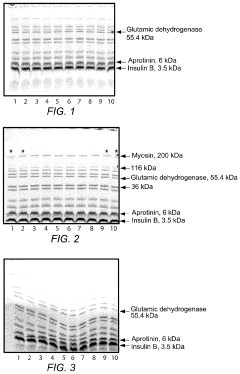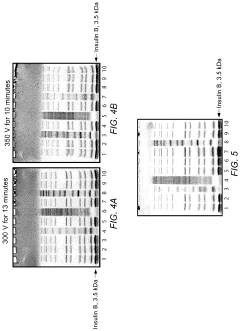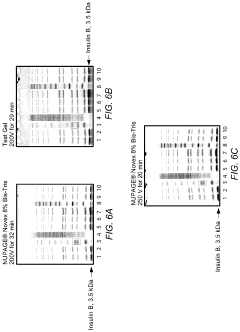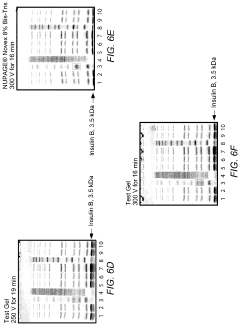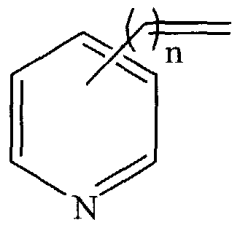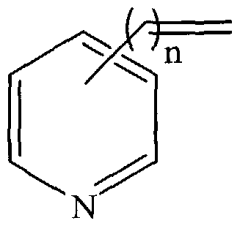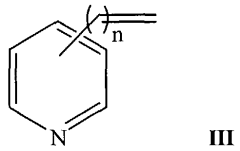How to Elevate Resolution in Cross-Linked Gel Electrophoresis?
JUL 1, 20259 MIN READ
Generate Your Research Report Instantly with AI Agent
Patsnap Eureka helps you evaluate technical feasibility & market potential.
Gel Electrophoresis Evolution and Objectives
Gel electrophoresis has been a cornerstone technique in molecular biology since its inception in the 1960s. This method, which separates molecules based on their size and electrical charge, has undergone significant evolution over the decades. Initially developed for protein separation, it quickly found applications in DNA and RNA analysis, becoming an indispensable tool in genomics research.
The primary objective of gel electrophoresis has always been to achieve high-resolution separation of biomolecules. As research demands have grown more sophisticated, there has been a continuous push to improve the resolution, sensitivity, and reproducibility of this technique. The advent of cross-linked gel electrophoresis marked a significant milestone in this evolution, offering enhanced stability and separation capabilities.
Cross-linked gel electrophoresis, particularly using polyacrylamide gels, has become the gold standard for high-resolution separation of proteins and small nucleic acids. The cross-linking of acrylamide monomers creates a three-dimensional mesh with precisely controlled pore sizes, allowing for exquisite molecular sieving. This advancement has enabled researchers to resolve proteins differing by as little as one amino acid and DNA fragments varying by a single base pair.
However, as the complexity of biological samples increases and the need for more precise molecular characterization grows, there is a constant drive to further elevate the resolution of cross-linked gel electrophoresis. The current objectives in this field focus on several key areas: enhancing the separation of closely related molecules, improving the detection of low-abundance species, and increasing the dynamic range of separation.
One of the primary goals is to develop gel formulations and running conditions that can provide even finer discrimination between molecules of similar size and charge. This is particularly crucial in proteomics research, where post-translational modifications can cause subtle changes in protein properties that are challenging to resolve with current techniques.
Another important objective is to increase the loading capacity of gels without compromising resolution. This would allow for the analysis of more complex samples and the detection of rare molecular species. Researchers are exploring various approaches, including the development of novel cross-linking agents and the optimization of gel porosity gradients.
The integration of gel electrophoresis with advanced detection methods is also a key focus. Efforts are underway to combine high-resolution separation with sensitive fluorescence detection, mass spectrometry, and even single-molecule imaging techniques. These hybrid approaches aim to not only separate molecules with high precision but also to provide detailed structural and quantitative information.
As we look to the future, the evolution of cross-linked gel electrophoresis continues to be driven by the need for ever-increasing resolution and analytical power. The field is poised for exciting developments that promise to unlock new insights into the molecular complexity of biological systems.
The primary objective of gel electrophoresis has always been to achieve high-resolution separation of biomolecules. As research demands have grown more sophisticated, there has been a continuous push to improve the resolution, sensitivity, and reproducibility of this technique. The advent of cross-linked gel electrophoresis marked a significant milestone in this evolution, offering enhanced stability and separation capabilities.
Cross-linked gel electrophoresis, particularly using polyacrylamide gels, has become the gold standard for high-resolution separation of proteins and small nucleic acids. The cross-linking of acrylamide monomers creates a three-dimensional mesh with precisely controlled pore sizes, allowing for exquisite molecular sieving. This advancement has enabled researchers to resolve proteins differing by as little as one amino acid and DNA fragments varying by a single base pair.
However, as the complexity of biological samples increases and the need for more precise molecular characterization grows, there is a constant drive to further elevate the resolution of cross-linked gel electrophoresis. The current objectives in this field focus on several key areas: enhancing the separation of closely related molecules, improving the detection of low-abundance species, and increasing the dynamic range of separation.
One of the primary goals is to develop gel formulations and running conditions that can provide even finer discrimination between molecules of similar size and charge. This is particularly crucial in proteomics research, where post-translational modifications can cause subtle changes in protein properties that are challenging to resolve with current techniques.
Another important objective is to increase the loading capacity of gels without compromising resolution. This would allow for the analysis of more complex samples and the detection of rare molecular species. Researchers are exploring various approaches, including the development of novel cross-linking agents and the optimization of gel porosity gradients.
The integration of gel electrophoresis with advanced detection methods is also a key focus. Efforts are underway to combine high-resolution separation with sensitive fluorescence detection, mass spectrometry, and even single-molecule imaging techniques. These hybrid approaches aim to not only separate molecules with high precision but also to provide detailed structural and quantitative information.
As we look to the future, the evolution of cross-linked gel electrophoresis continues to be driven by the need for ever-increasing resolution and analytical power. The field is poised for exciting developments that promise to unlock new insights into the molecular complexity of biological systems.
Market Demand Analysis for High-Resolution Gel Electrophoresis
The market demand for high-resolution gel electrophoresis has been steadily increasing, driven by advancements in molecular biology, genomics, and proteomics research. This technique plays a crucial role in various applications, including DNA sequencing, protein analysis, and genetic fingerprinting, making it indispensable in both academic and industrial settings.
In the pharmaceutical and biotechnology sectors, there is a growing need for more precise and sensitive analytical tools to support drug discovery and development processes. High-resolution gel electrophoresis enables researchers to separate and analyze complex mixtures of biomolecules with greater accuracy, facilitating the identification of potential drug targets and the assessment of drug efficacy.
The academic research community represents a significant portion of the market demand, as universities and research institutions continually seek to improve their analytical capabilities. With the increasing complexity of genomic and proteomic studies, there is a pressing need for electrophoresis systems that can provide higher resolution and better separation of closely related molecules.
Clinical diagnostics is another area driving the demand for high-resolution gel electrophoresis. As personalized medicine gains traction, there is a growing requirement for more sensitive and specific diagnostic tools. Improved resolution in gel electrophoresis can lead to earlier detection of genetic disorders, more accurate cancer diagnoses, and better monitoring of treatment responses.
The food and beverage industry is also contributing to the market demand, particularly in the realm of food safety and quality control. High-resolution gel electrophoresis techniques are increasingly used to detect food adulterations, verify product authenticity, and ensure compliance with regulatory standards.
Environmental monitoring and forensic science applications are expanding the market for high-resolution gel electrophoresis. These fields require precise analytical tools for tasks such as identifying environmental pollutants or analyzing DNA evidence in criminal investigations.
Geographically, North America and Europe currently dominate the market due to their well-established research infrastructure and significant investments in life sciences. However, the Asia-Pacific region is expected to show the highest growth rate in the coming years, driven by increasing research activities and government initiatives to boost biotechnology and pharmaceutical sectors.
The global market for electrophoresis equipment and supplies, including high-resolution systems, is projected to grow significantly. This growth is fueled by technological advancements, increasing research and development activities, and the rising prevalence of chronic diseases necessitating improved diagnostic tools.
As the demand for higher resolution in gel electrophoresis continues to rise, there is a parallel increase in the need for complementary technologies and consumables. This includes advanced imaging systems, specialized software for data analysis, and high-quality reagents and gels designed for optimal separation and resolution.
In the pharmaceutical and biotechnology sectors, there is a growing need for more precise and sensitive analytical tools to support drug discovery and development processes. High-resolution gel electrophoresis enables researchers to separate and analyze complex mixtures of biomolecules with greater accuracy, facilitating the identification of potential drug targets and the assessment of drug efficacy.
The academic research community represents a significant portion of the market demand, as universities and research institutions continually seek to improve their analytical capabilities. With the increasing complexity of genomic and proteomic studies, there is a pressing need for electrophoresis systems that can provide higher resolution and better separation of closely related molecules.
Clinical diagnostics is another area driving the demand for high-resolution gel electrophoresis. As personalized medicine gains traction, there is a growing requirement for more sensitive and specific diagnostic tools. Improved resolution in gel electrophoresis can lead to earlier detection of genetic disorders, more accurate cancer diagnoses, and better monitoring of treatment responses.
The food and beverage industry is also contributing to the market demand, particularly in the realm of food safety and quality control. High-resolution gel electrophoresis techniques are increasingly used to detect food adulterations, verify product authenticity, and ensure compliance with regulatory standards.
Environmental monitoring and forensic science applications are expanding the market for high-resolution gel electrophoresis. These fields require precise analytical tools for tasks such as identifying environmental pollutants or analyzing DNA evidence in criminal investigations.
Geographically, North America and Europe currently dominate the market due to their well-established research infrastructure and significant investments in life sciences. However, the Asia-Pacific region is expected to show the highest growth rate in the coming years, driven by increasing research activities and government initiatives to boost biotechnology and pharmaceutical sectors.
The global market for electrophoresis equipment and supplies, including high-resolution systems, is projected to grow significantly. This growth is fueled by technological advancements, increasing research and development activities, and the rising prevalence of chronic diseases necessitating improved diagnostic tools.
As the demand for higher resolution in gel electrophoresis continues to rise, there is a parallel increase in the need for complementary technologies and consumables. This includes advanced imaging systems, specialized software for data analysis, and high-quality reagents and gels designed for optimal separation and resolution.
Current Challenges in Cross-Linked Gel Electrophoresis
Cross-linked gel electrophoresis, a powerful technique for separating and analyzing biomolecules, faces several significant challenges that limit its resolution and overall effectiveness. One of the primary issues is the inherent heterogeneity of cross-linked gels, which can lead to inconsistent pore sizes and irregular migration patterns. This variability affects the reproducibility of results and makes it difficult to achieve high-resolution separation of closely related molecules.
Another major challenge is the limited range of molecular weights that can be effectively separated using a single gel composition. As the size of the molecules increases, the resolution decreases, particularly for larger proteins or nucleic acids. This limitation often necessitates the use of multiple gel concentrations or gradient gels, which can be time-consuming and resource-intensive.
The formation of non-specific aggregates during electrophoresis poses an additional hurdle. These aggregates can distort band patterns and lead to misinterpretation of results. The problem is particularly pronounced when dealing with complex biological samples or when analyzing proteins prone to aggregation.
Gel-to-gel variations present a significant obstacle in achieving consistent and comparable results across different experiments. Factors such as polymerization conditions, temperature fluctuations, and even minor differences in gel composition can lead to discrepancies in migration patterns and band resolution.
The limited dynamic range of traditional staining methods further compounds the resolution challenges. Many commonly used stains have a narrow linear range for quantification, making it difficult to accurately detect and quantify both high and low abundance molecules in the same gel.
Joule heating during electrophoresis can cause band distortion and reduced resolution, especially in thicker gels or when using higher voltages. This thermal effect can lead to uneven migration across the gel and compromise the overall separation quality.
The presence of contaminants or impurities in samples can interfere with the electrophoretic separation process, leading to smeared or diffuse bands. This issue is particularly problematic when working with complex biological samples or environmental specimens.
Lastly, the time-consuming nature of gel preparation and the relatively long run times required for high-resolution separation remain significant challenges. These factors limit the throughput of cross-linked gel electrophoresis and make it less suitable for large-scale or time-sensitive applications.
Addressing these challenges is crucial for advancing the field of cross-linked gel electrophoresis and improving its utility in various research and diagnostic applications. Innovations in gel formulations, electrophoresis protocols, and detection methods are needed to overcome these limitations and enhance the resolution and reliability of this important analytical technique.
Another major challenge is the limited range of molecular weights that can be effectively separated using a single gel composition. As the size of the molecules increases, the resolution decreases, particularly for larger proteins or nucleic acids. This limitation often necessitates the use of multiple gel concentrations or gradient gels, which can be time-consuming and resource-intensive.
The formation of non-specific aggregates during electrophoresis poses an additional hurdle. These aggregates can distort band patterns and lead to misinterpretation of results. The problem is particularly pronounced when dealing with complex biological samples or when analyzing proteins prone to aggregation.
Gel-to-gel variations present a significant obstacle in achieving consistent and comparable results across different experiments. Factors such as polymerization conditions, temperature fluctuations, and even minor differences in gel composition can lead to discrepancies in migration patterns and band resolution.
The limited dynamic range of traditional staining methods further compounds the resolution challenges. Many commonly used stains have a narrow linear range for quantification, making it difficult to accurately detect and quantify both high and low abundance molecules in the same gel.
Joule heating during electrophoresis can cause band distortion and reduced resolution, especially in thicker gels or when using higher voltages. This thermal effect can lead to uneven migration across the gel and compromise the overall separation quality.
The presence of contaminants or impurities in samples can interfere with the electrophoretic separation process, leading to smeared or diffuse bands. This issue is particularly problematic when working with complex biological samples or environmental specimens.
Lastly, the time-consuming nature of gel preparation and the relatively long run times required for high-resolution separation remain significant challenges. These factors limit the throughput of cross-linked gel electrophoresis and make it less suitable for large-scale or time-sensitive applications.
Addressing these challenges is crucial for advancing the field of cross-linked gel electrophoresis and improving its utility in various research and diagnostic applications. Innovations in gel formulations, electrophoresis protocols, and detection methods are needed to overcome these limitations and enhance the resolution and reliability of this important analytical technique.
Existing High-Resolution Gel Electrophoresis Techniques
01 Gel composition and cross-linking agents
The composition of the gel and the choice of cross-linking agents play a crucial role in improving the resolution of cross-linked gel electrophoresis. Specific combinations of monomers, cross-linkers, and additives can enhance separation efficiency and resolution of biomolecules. Optimizing these components can lead to better pore size distribution and overall gel performance.- Composition of cross-linked gel for improved resolution: Cross-linked gels with specific compositions can enhance electrophoresis resolution. These gels may include acrylamide monomers, cross-linking agents, and other additives that improve separation efficiency and clarity of bands. The composition can be optimized for different types of biomolecules and separation requirements.
- Gradient gel electrophoresis techniques: Gradient gel electrophoresis employs a gel with varying concentrations of cross-linking agents or acrylamide to improve resolution across a wide range of molecular weights. This technique allows for better separation of complex mixtures and can be applied to both proteins and nucleic acids.
- Novel cross-linking agents for improved gel properties: The use of novel cross-linking agents can enhance gel properties, leading to improved resolution in electrophoresis. These agents may offer better mechanical stability, increased pore size control, or reduced background interference, resulting in clearer and more distinct separation of biomolecules.
- Optimization of electrophoresis conditions: Optimizing electrophoresis conditions, such as buffer composition, voltage, and temperature, can significantly improve resolution in cross-linked gel electrophoresis. These parameters can be adjusted to enhance separation efficiency and reduce band broadening, resulting in sharper and more distinct bands.
- Post-electrophoresis treatments for enhanced resolution: Various post-electrophoresis treatments can be applied to improve the resolution and visibility of separated bands. These may include staining techniques, gel drying methods, or image analysis procedures that enhance the contrast and clarity of the electrophoresis results.
02 Temperature control and gradient formation
Controlling the temperature during gel formation and electrophoresis can significantly impact resolution. Temperature gradients can be used to create unique separation environments. Additionally, forming concentration gradients of cross-linking agents or monomers within the gel can enhance the separation of molecules with different sizes and properties.Expand Specific Solutions03 Novel electrode designs and buffer systems
Innovative electrode designs and buffer systems can improve the resolution of cross-linked gel electrophoresis. These advancements can lead to more uniform electric fields and better control of ion movement, resulting in sharper bands and improved separation of biomolecules.Expand Specific Solutions04 Integration of nanomaterials and microfluidics
Incorporating nanomaterials into cross-linked gels and integrating microfluidic systems can enhance resolution and separation efficiency. These advanced materials and techniques allow for finer control of pore size, improved sample loading, and more precise separation of biomolecules.Expand Specific Solutions05 Detection and imaging techniques
Advanced detection and imaging techniques can significantly improve the resolution and analysis of cross-linked gel electrophoresis results. These methods may include fluorescence-based detection, high-resolution imaging systems, and computer-aided analysis to enhance the visibility and quantification of separated biomolecules.Expand Specific Solutions
Key Players in Gel Electrophoresis Industry
The cross-linked gel electrophoresis market is in a mature stage, with established technologies and widespread adoption in research and clinical applications. The global market size for electrophoresis equipment and supplies is estimated to be over $1 billion, driven by increasing demand in proteomics, genomics, and diagnostics. Technologically, while innovations continue, the core principles are well-established. Key players like Agilent Technologies, Bio-Techne (ProteinSimple), and Life Technologies (now part of Thermo Fisher) offer advanced systems with improved resolution and automation. Academic institutions such as Shanghai Jiao Tong University and companies like Sharp Corp. are also contributing to incremental advancements in gel electrophoresis techniques and applications.
ProteinSimple
Technical Solution: ProteinSimple has developed the Simple Western system, which automates and standardizes traditional Western blot techniques. This system utilizes capillary electrophoresis to separate proteins based on size, followed by immobilization and immunodetection. The technology incorporates a stacking and separation matrix within capillaries, allowing for higher resolution and reproducibility compared to traditional slab gels [1]. The system also employs a photoactivated capture chemistry to immobilize separated proteins directly onto the capillary wall, enabling in-capillary immunodetection and eliminating the need for manual transfer steps [2]. This approach significantly improves resolution by minimizing band broadening and diffusion effects typically seen in gel-to-membrane transfers.
Strengths: Automated process reduces variability; improved resolution and reproducibility; reduced sample and antibody consumption. Weaknesses: Limited to smaller proteins (<230 kDa); may require optimization for certain protein types.
Life Technologies Corp.
Technical Solution: Life Technologies (now part of Thermo Fisher Scientific) has developed several technologies to enhance resolution in gel electrophoresis. One notable innovation is the E-Gel system, which uses precast agarose gels with a built-in ethidium bromide stain. The system employs a novel buffer chemistry that allows for faster run times and sharper band resolution [5]. Additionally, Life Technologies has introduced the Novex line of precast polyacrylamide gels, which feature gradient gels with optimized acrylamide concentrations to improve protein separation and resolution. The company has also developed the E-Gel Power Snap Electrophoresis Device, which combines electrophoresis and imaging in a single instrument, allowing for real-time monitoring of band separation and optimization of run conditions to enhance resolution [6].
Strengths: Precast gels ensure consistency; integrated staining reduces handling steps; real-time monitoring allows for run optimization. Weaknesses: Proprietary gel formats may limit flexibility; higher cost compared to self-cast gels.
Innovative Approaches to Enhance Gel Resolution
System for rapid high-resolution GEL electrophoresis
PatentActiveUS20190391113A1
Innovation
- The development of electrophoretic systems and formulations that allow for higher field strengths up to 50% more than conventional systems, using a discontinuous buffer system with specific gel amine and ampholyte buffers, and a pH range of 5.5 to 7.5, enabling faster separation of proteins within 30 minutes or less, even at higher voltages.
Method for enhancing two-dimensional GEL electrophoresis resolution
PatentWO2007015697A2
Innovation
- A method involving complete reduction and alkylation of polypeptides using trialkylphosphines like tris(2-carboxyethyl)-phosphine hydrochloride (TCEP) followed by vinylpyridine as the alkylating agent, ensuring greater than 90% alkylation of cysteine residues, thereby preventing disulfide cross-linking during electrophoresis.
Standardization and Quality Control in Gel Electrophoresis
Standardization and quality control are crucial aspects of gel electrophoresis, particularly when aiming to elevate resolution in cross-linked gel systems. Implementing rigorous protocols and maintaining consistent practices across laboratories is essential for achieving reproducible and high-quality results.
One of the primary considerations in standardization is the preparation of gel solutions. Precise measurements of acrylamide concentration, cross-linker ratios, and buffer compositions are critical for maintaining consistent pore sizes and separation characteristics. Laboratories should establish standard operating procedures (SOPs) for gel preparation, including detailed instructions for weighing chemicals, mixing solutions, and degassing to ensure uniformity.
Quality control measures for gel casting involve careful monitoring of polymerization conditions. Temperature, time, and the concentrations of catalysts and initiators must be tightly controlled to achieve consistent gel structures. Regular testing of gel quality using standard markers or reference samples can help identify variations in separation performance.
Electrophoresis running conditions also require standardization. Voltage, current, and run time should be optimized for specific applications and consistently applied across experiments. Buffer systems must be carefully prepared and maintained at the correct pH and ionic strength to ensure optimal separation and prevent artifacts.
Sample preparation is another critical area for quality control. Standardized protocols for sample collection, storage, and loading are essential for obtaining reliable results. Implementing guidelines for sample volume, concentration, and buffer compatibility can significantly improve resolution and reproducibility.
Imaging and analysis procedures should also be standardized to ensure accurate interpretation of results. Calibration of imaging equipment, use of consistent exposure settings, and application of validated analysis software contribute to reliable quantification and comparison of electrophoretic data.
Interlaboratory proficiency testing and the use of reference materials can help establish and maintain quality standards across different research groups. Participation in round-robin studies and the exchange of standardized samples can identify discrepancies in methodologies and promote harmonization of techniques.
Documentation and traceability are fundamental to effective quality control. Detailed record-keeping of reagent sources, lot numbers, and preparation dates, along with comprehensive documentation of experimental conditions, enables troubleshooting and ensures reproducibility over time.
By implementing these standardization and quality control measures, researchers can significantly enhance the resolution and reliability of cross-linked gel electrophoresis experiments, leading to more robust and comparable results across the scientific community.
One of the primary considerations in standardization is the preparation of gel solutions. Precise measurements of acrylamide concentration, cross-linker ratios, and buffer compositions are critical for maintaining consistent pore sizes and separation characteristics. Laboratories should establish standard operating procedures (SOPs) for gel preparation, including detailed instructions for weighing chemicals, mixing solutions, and degassing to ensure uniformity.
Quality control measures for gel casting involve careful monitoring of polymerization conditions. Temperature, time, and the concentrations of catalysts and initiators must be tightly controlled to achieve consistent gel structures. Regular testing of gel quality using standard markers or reference samples can help identify variations in separation performance.
Electrophoresis running conditions also require standardization. Voltage, current, and run time should be optimized for specific applications and consistently applied across experiments. Buffer systems must be carefully prepared and maintained at the correct pH and ionic strength to ensure optimal separation and prevent artifacts.
Sample preparation is another critical area for quality control. Standardized protocols for sample collection, storage, and loading are essential for obtaining reliable results. Implementing guidelines for sample volume, concentration, and buffer compatibility can significantly improve resolution and reproducibility.
Imaging and analysis procedures should also be standardized to ensure accurate interpretation of results. Calibration of imaging equipment, use of consistent exposure settings, and application of validated analysis software contribute to reliable quantification and comparison of electrophoretic data.
Interlaboratory proficiency testing and the use of reference materials can help establish and maintain quality standards across different research groups. Participation in round-robin studies and the exchange of standardized samples can identify discrepancies in methodologies and promote harmonization of techniques.
Documentation and traceability are fundamental to effective quality control. Detailed record-keeping of reagent sources, lot numbers, and preparation dates, along with comprehensive documentation of experimental conditions, enables troubleshooting and ensures reproducibility over time.
By implementing these standardization and quality control measures, researchers can significantly enhance the resolution and reliability of cross-linked gel electrophoresis experiments, leading to more robust and comparable results across the scientific community.
Environmental Impact of Gel Electrophoresis Materials
Gel electrophoresis, while a powerful analytical technique, raises environmental concerns due to the materials used in the process. The primary components of concern are the gel matrix, typically made of polyacrylamide or agarose, and the buffer solutions containing various salts and chemicals.
Polyacrylamide gels, commonly used for higher resolution separations, pose significant environmental risks. Acrylamide, the monomer used to create these gels, is a known neurotoxin and potential carcinogen. Improper disposal of polyacrylamide gels can lead to soil and water contamination, potentially affecting aquatic ecosystems and human health. The crosslinking agents used in these gels, such as N,N'-methylenebisacrylamide, also contribute to environmental toxicity.
Agarose gels, while less toxic than polyacrylamide, still present environmental challenges. The production of agarose from seaweed can impact marine ecosystems if not managed sustainably. Additionally, the disposal of used agarose gels contributes to solid waste accumulation in landfills, as these gels are not readily biodegradable.
The buffer solutions used in gel electrophoresis often contain chemicals such as Tris, boric acid, and EDTA. These compounds can alter soil and water pH levels when improperly disposed of, potentially disrupting local ecosystems. Furthermore, some buffers may contain heavy metals or other toxic substances that can bioaccumulate in the food chain.
Staining agents used to visualize DNA or proteins in gels also pose environmental risks. Ethidium bromide, a common DNA stain, is a potent mutagen and potential carcinogen. Its release into the environment can have detrimental effects on aquatic life and potentially contaminate groundwater. Alternative stains, while often marketed as safer, may still have unknown long-term environmental impacts.
The energy consumption of gel electrophoresis equipment contributes to the technique's carbon footprint. Prolonged run times and the need for temperature control in some applications result in significant electricity usage, indirectly contributing to greenhouse gas emissions depending on the energy source.
To mitigate these environmental impacts, researchers and laboratories are exploring more sustainable alternatives. These include the development of biodegradable gel materials, the use of less toxic staining agents, and the implementation of more efficient electrophoresis systems. Additionally, proper waste management protocols, including the treatment of liquid waste and the appropriate disposal of gel materials, are crucial in minimizing the environmental footprint of gel electrophoresis techniques.
Polyacrylamide gels, commonly used for higher resolution separations, pose significant environmental risks. Acrylamide, the monomer used to create these gels, is a known neurotoxin and potential carcinogen. Improper disposal of polyacrylamide gels can lead to soil and water contamination, potentially affecting aquatic ecosystems and human health. The crosslinking agents used in these gels, such as N,N'-methylenebisacrylamide, also contribute to environmental toxicity.
Agarose gels, while less toxic than polyacrylamide, still present environmental challenges. The production of agarose from seaweed can impact marine ecosystems if not managed sustainably. Additionally, the disposal of used agarose gels contributes to solid waste accumulation in landfills, as these gels are not readily biodegradable.
The buffer solutions used in gel electrophoresis often contain chemicals such as Tris, boric acid, and EDTA. These compounds can alter soil and water pH levels when improperly disposed of, potentially disrupting local ecosystems. Furthermore, some buffers may contain heavy metals or other toxic substances that can bioaccumulate in the food chain.
Staining agents used to visualize DNA or proteins in gels also pose environmental risks. Ethidium bromide, a common DNA stain, is a potent mutagen and potential carcinogen. Its release into the environment can have detrimental effects on aquatic life and potentially contaminate groundwater. Alternative stains, while often marketed as safer, may still have unknown long-term environmental impacts.
The energy consumption of gel electrophoresis equipment contributes to the technique's carbon footprint. Prolonged run times and the need for temperature control in some applications result in significant electricity usage, indirectly contributing to greenhouse gas emissions depending on the energy source.
To mitigate these environmental impacts, researchers and laboratories are exploring more sustainable alternatives. These include the development of biodegradable gel materials, the use of less toxic staining agents, and the implementation of more efficient electrophoresis systems. Additionally, proper waste management protocols, including the treatment of liquid waste and the appropriate disposal of gel materials, are crucial in minimizing the environmental footprint of gel electrophoresis techniques.
Unlock deeper insights with Patsnap Eureka Quick Research — get a full tech report to explore trends and direct your research. Try now!
Generate Your Research Report Instantly with AI Agent
Supercharge your innovation with Patsnap Eureka AI Agent Platform!
